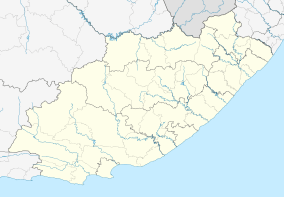Cookhouse
| Cookhouse Kookhuis | |
|---|---|
|
Cookhouse station sign | |
 Cookhouse  Cookhouse Cookhouse (South Africa)  Cookhouse Cookhouse (Africa) | |
| Coordinates: 32°44′43″S 25°48′17″E / 32.74528°S 25.80472°ECoordinates: 32°44′43″S 25°48′17″E / 32.74528°S 25.80472°E | |
| Country | South Africa |
| Province | Eastern Cape |
| District | Sarah Baartman |
| Municipality | Blue Crane Route |
| Government | |
| • Type | Ward 01 |
| • Councillor | Ntombentsha Glenda Mjikelo (ANC) |
| Area[1] | |
| • Total | 50.98 km2 (19.68 sq mi) |
| Population (2011)[1] | |
| • Total | 5,707 |
| • Density | 110/km2 (290/sq mi) |
| Racial makeup (2011)[1] | |
| • Black African | 80.7% |
| • Coloured | 16.0% |
| • Indian/Asian | 0.2% |
| • White | 2.8% |
| • Other | 0.4% |
| First languages (2011)[1] | |
| • Xhosa | 75.4% |
| • Afrikaans | 19.7% |
| • English | 2.5% |
| • Other | 2.4% |
| Time zone | UTC+2 (SAST) |
| Postal code (street) | 5820 |
| PO box | 5820 |
| Area code | 042 |
Cookhouse (Afrikaans: Kookhuis) is a small village located in Eastern Cape province, South Africa, some 170 kilometres (110 mi) north of Port Elizabeth and 24 kilometres (15 mi) east of Somerset East, on the west bank of the Great Fish River.
Cookhouse is situated in Greater Addo, in the Eastern Cape, South Africa. Cookhouse was an early colonial settlement. The Scottish abolitionist and poet, Thomas Pringle mentions Cookhouse in his journal. The town was also visited by early explorers and writers such as Dutch military commander Robert Jacob Gordon and French traveller François le Vaillant. Gordon’s stay in South Africa produced scientific writings, drawings and maps about the region.[2]
The town is home to the Cookhouse Wind Farm which comprises 66 turbines. The farm became operational in November 2014 and supplies clean energy to Cookhouse, Adelaide, Somerset East and Bedford.[3]
History
The Great Fish River formed the eastern boundary of the Cape Colony until 1819. The current village is said to take its name from a small stone house used for shelter and cooking by troops camping on the bank of this river. Another explanation links the name to the hot climate as experienced by the troops stationed there.[4]
The Cookhouse is located on what was the Roodewal farm owned by Frans Johannes in the 1770s. Johannes was born on the 12th September 1777 in Somerset East and died in 1856. Johannes was married twice; first to Susanna Wilhelmina Tregardt on 21 October 1798. She died in 1825 aged 27.[5] This small town got its name is in the late 1790s because Tregardt supplied provisions from her “cookhouse” (or outdoor kitchen) to riders and soldiers waiting to cross the Great Fish River. After her death, Johannes married Maria Johanna Mentz in 1826.
In the 1870s, the government of Prime Minister John Molteno oversaw a massive expansion of the Cape Colony's railway system, and a route northwards to De Aar from Port Elizabeth and Port Alfred was chosen by the Cape Government Railways to pass through what is now Cookhouse. A station was built here, which became an important railway junction, and a small settlement formed around this connection.[6]
This railway station in Cookhouse is an attraction was written about in Cookhouse Station, a poem by Chris Mann that describes how he imagines the railway station was at its peak.[7]
Monuments and Museums
- Cookhouse is home to the Slachter’s Nek monument, commemorating the hanging of the five rebels of the Slachter's Nek Rebellion who were sentenced by the British to be hanged in public. The monument was erected in 1916, 100 years after the execution.[8]
- Cookhouse is home to Thomas Pringle’s Cairn, a memorial built to commemorate his passage through the town.
- The Fallen Heroes monument was unveiled in 2011 to commemorate the lives of Cookhouse residents who lost their lives in the struggle against apartheid in South Africa.
- The Fairworld Fine Wool Museum is also located in Cookhouse and it shows the history of farming and wool production in the town.[8] Willen van Aardt established the museum to tell the story of Fine Wool breeding on the farm as well as the history of the van Aardt family who have produced wool on the farm since 1797. The Fairwold Merino holds the current South African record price of for a Merino ram.
References
- 1 2 3 4 "Main Place Cookhouse". Census 2011.
- ↑ Huigen, Siegfried (2009). Knowledge and Colonialism: Eighteenth-Century Travellers in South Africa. Leiden: Koninklijke Brill. p. 93. ISBN 90-04-17743-4.
- ↑ Barbee, Jeff (1 June 2015). "How renewable energy in South Africa is quietly stealing a march on coal". the Guardian. Retrieved 29 August 2018.
- ↑ Raper, P. E. (1989). Dictionary of Southern African Place Names. Jonathan Ball Publishers. p. 121. ISBN 978-0-947464-04-2 – via Internet Archive.
- ↑ Van Wyk, Ferdie (2016). "A Coveted Discovery". The Genealogical Society of South Africa. Retrieved 29 August 2018.
- ↑ Burman, Jose (1984). Early railways at the Cape. Cape Town: Human & Rousseau.
- ↑ Eve, Jeanette (2003). A Literary Guide to the Eastern Cape: Places and the Voices of Writers. Juta and Company. pp. 193–. ISBN 978-1-919930-15-2.
- 1 2 "Cookhouse". Blue Crane Route Tourism. n.d. Retrieved 29 August 2018.
.svg.png)